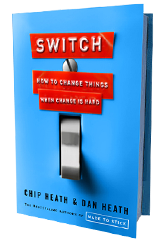 I’ve lost 3.5 pounds since January. My goal was to get to the gym every day of the week and because I’ve managed to do this (most days), I’ve lost some weight. I realize this isn’t very interesting or surprising. Everyone knows that exercising helps you lose weight. What is surprising is that, unbeknownst to me, the reason I trimmed a few pounds is because I’m doing something different. I’m following the “change pattern” outlined in Switch: How to
I’ve lost 3.5 pounds since January. My goal was to get to the gym every day of the week and because I’ve managed to do this (most days), I’ve lost some weight. I realize this isn’t very interesting or surprising. Everyone knows that exercising helps you lose weight. What is surprising is that, unbeknownst to me, the reason I trimmed a few pounds is because I’m doing something different. I’m following the “change pattern” outlined in Switch: How to  Create Change, when Change is Hard, the new book by brothers Chip and Dan Heath – the same co-authors whose previous bestseller was Made to Stick: Why Some Ideas Survive and Others Die.
Create Change, when Change is Hard, the new book by brothers Chip and Dan Heath – the same co-authors whose previous bestseller was Made to Stick: Why Some Ideas Survive and Others Die.
I’m sure you’re wondering what my personal weight loss has to do with the important social change effort that your nonprofit is attempting to undertake. According to the Heath brothers – a lot. In fact, they believe that there are general principles that apply to all changes – whether individual, organizational or societal. By outlining these principles in Switch they hope that more change efforts will succeed. This book’s message and advice seems especially important for nonprofit professionals whose work is all about achieving major social changes, to make the world a better place.
The Rider vs. The Elephant
The first principle of Switch is that change requires appealing to both our emotions and our reason. The Heath brothers put it this way:
“Our emotional side is like an Elephant and our rational side is its Rider. Perched atop the Elephant, the Rider holds the reins and seems to be the leader. But the Rider’s control is precarious because the Rider is so small relative to the Elephant. Anytime the six-ton Elephant and the Rider disagree about which direction to go, the Rider is going to lose. He’s completely overmatched.”
To succeed then, we must appeal to both the Rider and the Elephant in our would-be constituents. In my case, I remind myself that exercise will help me sleep better at night. But that’s not enough to get me to the gym every day. I’m also moved by the prospect of being more fit for a vacation this spring!
Unfortunately most organizational cultures emphasize reason over emotion. Thus, many of us spend far too much time appealing to the rational sides of our prospects’ brains. Armed with statistics on global warming, poverty and the high cost of the uninsured, we try to change behavior by appealing to reason. The problem is, knowledge is not enough. People need motivation to change and motivation comes from feeling.
Shape the Path
The second principle of Switch is that change requires a clear path. “That’s obvious,” you say. But read your mission statement and your strategic plan. Are your goals crystal clear? According to the Heath brothers, if you want to create change you’ve got to be pretty darn clear about where you’re going and what you need to do to get there. For example, you can’t assume that people know what you mean when you ask them to reduce carbon emissions or help solve the educational crisis. Instead, you’ve got to define clear goals. (Go to the gym 20 minutes a day.) You’ve also got to help people make the changes you seek. (Pack your gym bag the night before.)
By “tweaking the environment” [you make] the right behaviors a little bit easier and the wrong behaviors a little bit harder.” You also make it easier for people to develop new habits.
The good news is that according to Switch big change is possible and the Heath brothers give us an outline and numerous case studies to illuminate the path. This should be music to your ears if – like me – you’ve been eating too much cheese, wine and chocolate! It should also be music to your ears is you’re passionate about improving the environment, fixing the educational system or doing immigration reform.
I encourage you to read this book. In fact, I encourage you to comment below to receive a copy of Switch for FREE!
Tell us what you’re trying to change and why you need a copy of Switch. We’ll give away five FREE copies to the folks who need it most!
You should follow Frogloop on Twitter.


COMMENTS